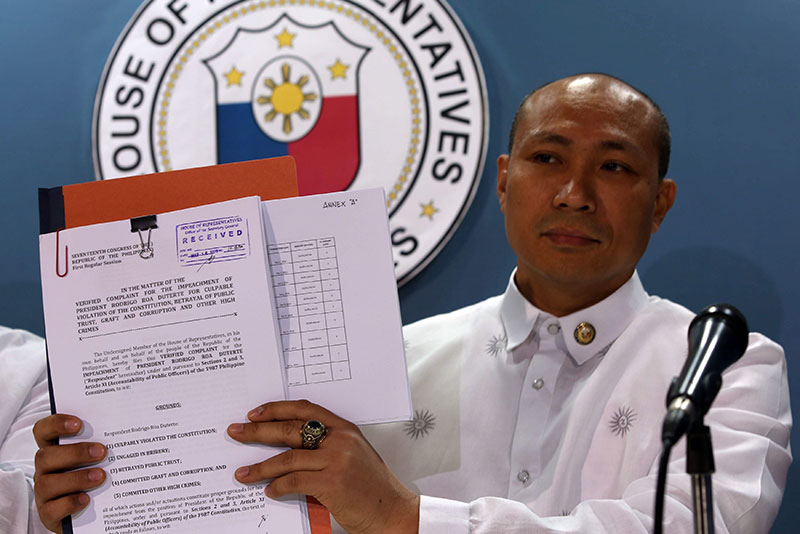QUEZON City, Philippines (May 20) – Planning to impeach an impeachable official? Better do it properly so it will not be dismissed due to a technicality.

But first, what is the process of impeachment? Impeachment has been defined as the method of national inquest into the conduct of public men. Its purpose is to protect the people from official delinquencies or malfeasance. Impeachment is primarily intended for the protection of the State, not for the punishment of the offender.
The President of the Republic of the Philippines is not the only official who can be impeached. Others include the Vice-President, the Members of the Supreme Court, the Members of the Constitutional Commissions, and the Ombudsman.
The grounds for impeachment can be found in Sec. 2, Article XI of the Constitution. An impeachable official may be impeached on the grounds of culpable violation of the Constitution, treason, bribery, graft and corruption, betrayal of public trust and other high crimes.
Lest there be confusion, the object of impeachment is to determine whether the official in question is still worthy of the trust conferred upon him or her. Impeachment does not determine guilt or innocence. The penalties imposed on impeached officials are removal from office and permanent disqualification from holding further office.
The power of impeachment is reposed on the two houses of the Congress. The House of Representatives initiates all cases of impeachment while the Senate tries and decides all cases of impeachment. When the President is impeached, the Chief Justice of the Supreme Court presides over the impeachment trial. In all other cases, the Senate President presides.

So, how do you impeach an impeachable official?
First, the filing of an impeachment complaint is done by a member of the House of Representatives or any citizen of the Republic of the Philippines with the endorsement of a member of the House of Representatives.

There are two procedures for impeachment.
One procedure involves 1/3 of all of the members of the House of Representatives filing an impeachment complaint or resolution. The Articles of Impeachment will be sent to the Senate for trial.
The normal procedure is followed when a member of the House of Representatives or a citizen filed a verified complaint. The complaint will be included in the Order of Business within 10 session days then it will be referred to the proper committee within three session days.
The committee will then conduct a hearing on the complaint, which is followed by a vote. If the committee votes “No,” the case is dismissed. If the committee votes “Yes,” the complaint is referred to the plenary within 60 days.

The plenary will then vote. If the complaint does not get the necessary 1/3 votes of all of the members of the House of Representatives, the complaint is dismissed. If the necessary 1/3 votes of all members voted in favor, the House of Representatives will issue a resolution and articles of impeachment which will be referred to the Senate. The House will also elect its prosecutors.
The Senate as plenary body will draft its rules on impeachment. The Senate will then vote on the adoption of the rules on impeachment. If the majority votes in favor of the adoption, the Senate will then convene as an impeachment court. If not, the rules may be revised until it is adopted.
The Senate will then issue a summons to the respondent or the official facing impeachment. The respondent will make an appearance and will file an answer. The Senate will then receive testimonial and documentary evidence. The Senate will also interpose questions. The Senate will then submit the case for voting.
A two-thirds vote is needed to convict an impeached official. Take note that proof beyond reasonable doubt is not needed to convict an impeached official as an impeachment is not a criminal case. The Senators are expected to vote according to their conscience.
It is important to remember is that Article XI Sec. 3 Par. 5 of the Constitution provides a limitation to the number of impeachment proceedings that can be initiated against the same official. It limits the number to no more than one per year.
The Supreme Court has the power to review impeachment cases, to guarantee that they conform and follow the procedures and requirements found in the Constitution. What the Supreme Court cannot review is the actual charge.

Historically speaking, six Presidents of the Philippines faced impeachment complaints. They are: President Elpidio Quirino, President Diosdado Macapagal, President Ferdinand Marcos, President Joseph Estrada, President Gloria Macapagal-Arroyo and just recently, President Rodrigo Duterte. Former President Gloria Macapagal-Arroyo holds the record for most impeachment complaints filed against her with three. All of them have had the respective impeachment complaints filed against them dismissed except one. President Joseph Estrada faced the impeachment court his impeachment trial but it was not able to rule for or against his conviction because he was cast out when EDSA People Power II took place.
(written by Jay Paul Carlos, additional research by Vince Alvin Villarin)







